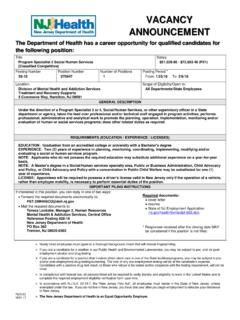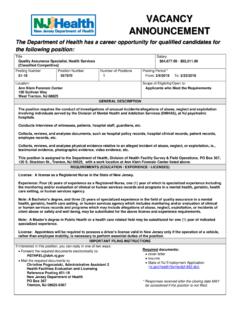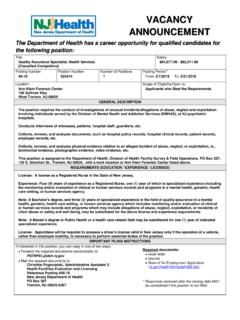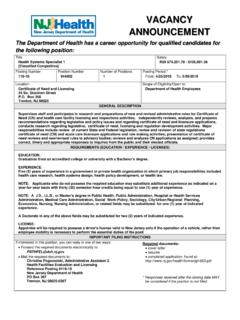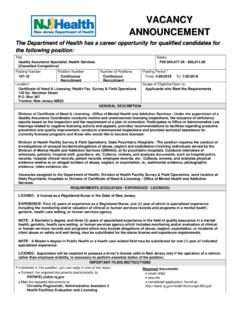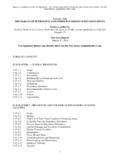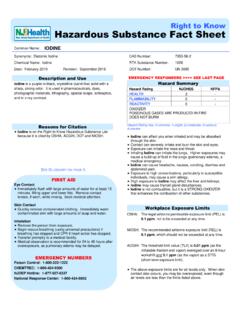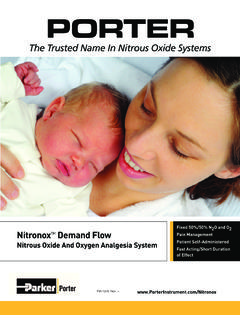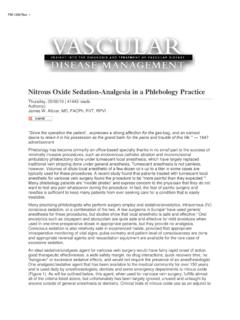Transcription of NITROUS OXIDE HAZARD SUMMARY - New Jersey
1 Common Name: NITROUS OXIDE CAS Number: 10024-97-2 DOT Number: UN 1070 (Compressed) UN 2201 (Refrigerated Liquid) ---------------------------------------- ----------------------------------- HAZARD SUMMARY * NITROUS OXIDE can affect you when breathed in. * NITROUS OXIDE should be handled as a TERATOGEN--WITH EXTREME CAUTION. * Contact with liquefied NITROUS OXIDE may cause skin burns and/or frostbite. * Breathing NITROUS OXIDE can irritate the eyes, nose and throat causing coughing and/or shortness of breath. * Exposure can cause you to feel lightheaded, giddy and sleepy. High levels can cause you to pass out and very high levels can cause death.
2 * Repeated exposure may damage the nervous system causing numbness, pins and needles, and weakness in the arms and legs. * NITROUS OXIDE may damage the blood cells. * NITROUS OXIDE may damage the liver and kidneys. IDENTIFICATION NITROUS OXIDE (laughing gas) is a colorless gas with a slightly sweet odor and taste. NITROUS OXIDE can be transported as a very low temperature (cryogenic) liquid. It is used as an anesthetic and a foaming agent for whipped cream. REASON FOR CITATION * NITROUS OXIDE is on the Hazardous Substance List because it is cited by ACGIH, DOT, NIOSH and IARC. * Definitions are provided on page 5.
3 HOW TO DETERMINE IF YOU ARE BEING EXPOSED The New Jersey Right to Know Act requires most employers to label chemicals in the workplace and requires public employers to provide their employees with information and training concerning chemical hazards and controls. The federal OSHA HAZARD Communication Standard, , requires private employers to provide similar training and information to their employees. RTK Substance number: 1399 Date: March 1998 Revision: September 2004 ---------------------------------------- ----------------------------------- * Exposure to hazardous substances should be routinely evaluated.
4 This may include collecting personal and area air samples. You can obtain copies of sampling results from your employer. You have a legal right to this information under OSHA * If you think you are experiencing any work-related health problems, see a doctor trained to recognize occupational diseases. Take this Fact Sheet with you. WORKPLACE EXPOSURE LIMITS NIOSH: The recommended airborne exposure limit is 25 ppm averaged over a 10-hour workshift. ACGIH: The recommended airborne exposure limit is 50 ppm averaged over an 8-hour workshift. * NITROUS OXIDE may be a teratogen in humans.
5 All contact with this chemical should be reduced to the lowest possible level. * Large amounts of NITROUS OXIDE will decrease the amount of available Oxygen. Oxygen content should be routinely tested to ensure that it is at least 19% by volume. WAYS OF REDUCING EXPOSURE * Where possible, enclose operations and use local exhaust ventilation at the site of chemical release. If local exhaust ventilation or enclosure is not used, respirators should be worn. * Wear protective work clothing. * On skin contact with liquefied NITROUS OXIDE , immediately submerse the affected body part in warm water.
6 * Post HAZARD and warning information in the work area. In addition, as part of an ongoing education and training effort, communicate all information on the health and safety hazards of NITROUS OXIDE to potentially exposed workers. NITROUS OXIDE page 2 of 6 This Fact Sheet is a SUMMARY source of information of all potential and most severe health hazards that may result from exposure. Duration of exposure, concentration of the substance and other factors will affect your susceptibility to any of the potential effects described below. ---------------------------------------- ----------------------------------- HEALTH HAZARD INFORMATION Acute Health Effects The following acute (short-term) health effects may occur immediately or shortly after exposure to NITROUS OXIDE : * Contact with liquefied NITROUS OXIDE may cause skin burns and/or frostbite.
7 * Breathing NITROUS OXIDE can irritate the eyes, nose and throat causing coughing and/or shortness of breath. * Exposure can cause you to feel lightheaded, giddy and sleepy. High levels can cause you to pass out and very high levels can cause death. Chronic Health Effects The following chronic (long-term) health effects can occur at some time after exposure to NITROUS OXIDE and can last for months or years: Cancer HAZARD * While NITROUS OXIDE has been tested, it is not classifiable as to its potential to cause cancer. Reproductive HAZARD * NITROUS OXIDE may be a TERATOGEN in humans since it has been shown to be a teratogen in animals.
8 Other Long-Term Effects * Repeated exposure may damage the nervous system causing numbness, pins and needles, and weakness in the arms and legs. * NITROUS OXIDE may damage the blood cells. * NITROUS OXIDE may damage the liver and kidneys. MEDICAL Medical Testing Before beginning employment and at regular times after that, for those with frequent or potentially high exposures, the following is recommended: * Exam of the nervous system. If symptoms develop or overexposure is suspected, the following are recommended: * Complete blood count. * Liver and kidney function tests. Any evaluation should include a careful history of past and present symptoms with an exam.
9 Medical tests that look for damage already done are not a substitute for controlling exposure. Request copies of your medical testing. You have a legal right to this information under OSHA Mixed Exposures * Because more than light alcohol consumption can cause liver damage, drinking alcohol can increase the liver damage caused by NITROUS OXIDE . WORKPLACE CONTROLS AND PRACTICES Unless a less toxic chemical can be substituted for a hazardous substance, ENGINEERING CONTROLS are the most effective way of reducing exposure. The best protection is to enclose operations and/or provide local exhaust ventilation at the site of chemical release.
10 Isolating operations can also reduce exposure. Using respirators or protective equipment is less effective than the controls mentioned above, but is sometimes necessary. In evaluating the controls present in your workplace, consider: (1) how hazardous the substance is, (2) how much of the substance is released into the workplace and (3) whether harmful skin or eye contact could occur. Special controls should be in place for highly toxic chemicals or when significant skin, eye, or breathing exposures are possible. In addition, the following controls are recommended: * Before entering a confined space where NITROUS OXIDE is present, check to make sure sufficient Oxygen (19%) exists.

